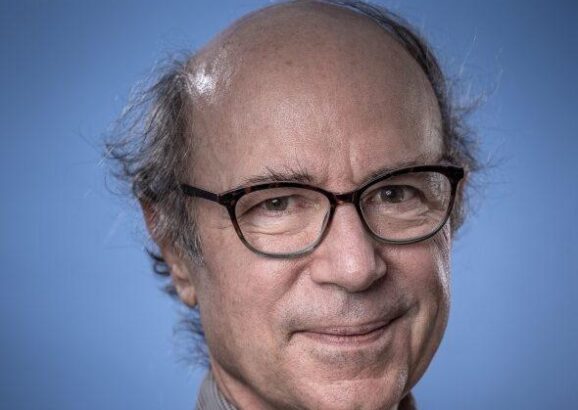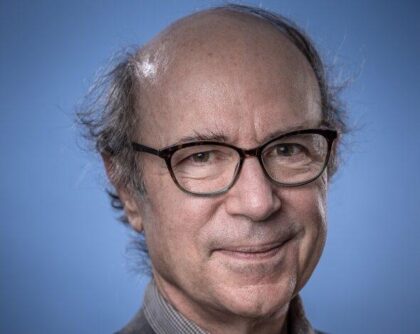Frank Wilczek
2004 Nobel Laureate
Research Interests
Courtesy of Big Think | YouTube
Professor Wilczek’s professional work has touched on a large variety of questions in theoretical physics. Abiding interests include:
- “pure” particle physics, especially connections between ambitious theoretical ideas and concrete observable phenomena (e.g. applications of asymptotic freedom, unification of couplings);
- the behavior of matter at ultra-high temperature and/or density (e.g. phase structure of QCD, application to cosmology, neutron stars and stellar explosions);
- the application of insights from particle physics to cosmology (e.g. axions as dark matter candidates, search techniques for these and for WIMPs);
- the application of field theory techniquesto condensed matter physics (e.g. exotic quantum numbers on solitons of various sorts, statistical transmutation and fractional statistics in the quantum Hall effect);
- the quantum theory of black holes (e.g. existence of quantum hair, classical hair and entropy of string-theoretic holes).
Courtesy of Quanta Magazine/YouTube
Biographical Sketch
Professor Frank Wilczek is considered one of the world’s most eminent theoretical physicists. He is known, among other things, for the discovery of asymptotic freedom, the development of quantum chromodynamics, the invention of axions, and the discovery and exploitation of new forms of quantum statistics (anyons). When only 21 years old and a graduate student at Princeton University, in work with David Gross he defined the properties of color gluons, which hold atomic nuclei together.
Professor Wilczek received his B.S. degree from the University of Chicago and his Ph.D. from Princeton University. He taught at Princeton from 1974–81. During the period 1981–88, he was the Chancellor Robert Huttenback Professor of Physics at the University of California at Santa Barbara, and the first permanent member of the National Science Foundation’s Institute for Theoretical Physics. In the fall of 2000, he moved from the Institute for Advanced Study, where he was the J.R. Oppenheimer Professor, to the MIT Department of Physics, where he is the Herman Feshbach Professor of Physics. Since 2002, he has been an Adjunct Professor in the Centro de Estudios Científicos of Valdivia, Chile.
Professor Wilczek has been a Sloan Foundation Fellow (1975-77) and a MacArthur Foundation Fellow (1982-87). He has received UNESCO’s Dirac Medal, the American Physical Society’s Sakurai Prize, the Michelson Prize from Case Western University, and the Lorentz Medal of the Netherlands Academy for his contributions to the development of theoretical physics. In 2004 he received the Nobel Prize in Physics, and in 2005 the King Faisal Prize. He is a member of the National Academy of Sciences, the Netherlands Academy of Sciences, and the American Academy of Arts and Sciences, and is a Trustee of the University of Chicago. He contributes regularly to Physics Today and to Nature, explaining topics at the frontiers of physics to wider scientific audiences. He received the Lilienfeld Prize of the American Physical Society for these activities. Two of his pieces have been anthologized in Best American Science Writing (2003, 2005). Together with his wife Betsy Devine, he wrote a beautiful book, Longing for the Harmonies (W.W. Norton).
More info:
Courtesy of MIT Infinite History Project | Infinite MIT

Frank Wilczek Receives 2022 Templeton Prize
Wilczek Joins Past Laureates Mother Teresa and Jane Goodall to Receive One of the World’s Largest Individual Lifetime Achievement Awards
Awards & Honors
- 2022 // Templeton Prize "recognized for his examination into the fundamental laws of nature."
- 2020 // First Prize Award from Gravity Research Foundation – “The Noise of Gravitons” (with Maulik Parikh, George Zahariade)
- 2016 // Richard E. Prange Prize, University of Maryland
- 2014 // First Prize Award from Gravity Research Foundation “From Bmodes to quantum gravity and unification of forces,” (with Lawrence Krauss)
- 2013 // Oskar Klein Medal, Stockholm University
- 2012 // Kosciuszko Foundation Medal of Recognition, Kosciuszko Foundation
- 2008 // Casimir Funk Award
- 2008 // Julius Wess Award (Inaugural), Karlsruhe Institute of Technology
- 2007 // Elected Fellow, Polish Academy of Arts and Sciences
- 2005 // Golden Plate Award, Academy of Achievement, New York
- 2005 // American Philosophical Society Member
- 2005 // King Faisal International Prize for Science, King Faisal Foundation
- 2004 // Nobel Prize in Physics (co-recipient with David Gross and H. David Politzer) “For the discovery of asymptotic freedom in the theory of the strong interaction.”
- 2004 // American Physical Society Fellow "For the discovery of asymptotic freedom in the theory of the strong interactions."
- 2003 // Commemorative Medal of the Faculty of Mathematics and Physics, Charles University, Prague
- 2003 // High Energy Physics Prize of the European Physical Society (EPS) (co-recipient with David Gross and H. David Politzer)
- 2003 // Julius Edgar Lilienfeld Prize (APS) "For his role in the development of asymptotic freedom and other aspects of quantum chromodynamics, a cornerstone of the standard model; for his remarkable versatility in research in condensed matter and astrophysics as well as particle physics; and for his outstanding ability to lecture and write with clarity, profundity, and enthusiasm."
- 2002 // Lorentz Medal, Royal Netherlands Academy of Arts and Science
- 2002 // Michelson-Morley Prize, Case Western Reserve University
- 2000 // American Association for Advancement of Science Elected Fellow
- 2000 // Elected Foreign Member, Royal Netherlands Academy of Arts and Sciences
- 1994 // Dirac Medal (ICTP) "for his contributions to the development of theoretical physics."
- 1993 // American Academy of Arts and Sciences Member
- 1990 // National Academy of Sciences Member
- 1986 // J. J. Sakurai Prize for Theoretical Particle Physics (APS) "For their analyses of nonabelian gauge theories at short distances, and the implications of these insights for the understanding of the strong interaction between quarks."
- 1982-87 // John & Catherine MacArthur Foundation Fellow
- 1975-77 // Arthur P Sloan Foundation Fellow
- 1973 // Ettore Majorana “Best Student” Prize
- 1969 // Phi Beta Kappa
- 1967 // Westinghouse Science Talent Search, 4th Prize
Key Publications
-
Quark Description of Hadronic Phases
 : A first cut at applying the lessons learned from color-flavor locking and quark-hadron continuity to real QCD, which is complicated by splitting between strange and light quarks. Both classic 2-flavor color superconductivity (with the strange quark passive) and color-flavor locking are valid groundstates in different parameter regimes at high density. An extremely intriguing possibility is that the 2-flavor color superconducting phase goes over into ordinary nuclear matter with no phase transition. This might qualitatively explain the small nuclear (compared to QCD) mass scale; it requires chiral symmetry restoration — which could explain the long-standing observation $g_A \rightarrow 1$ in nuclear matter.
: A first cut at applying the lessons learned from color-flavor locking and quark-hadron continuity to real QCD, which is complicated by splitting between strange and light quarks. Both classic 2-flavor color superconductivity (with the strange quark passive) and color-flavor locking are valid groundstates in different parameter regimes at high density. An extremely intriguing possibility is that the 2-flavor color superconducting phase goes over into ordinary nuclear matter with no phase transition. This might qualitatively explain the small nuclear (compared to QCD) mass scale; it requires chiral symmetry restoration — which could explain the long-standing observation $g_A \rightarrow 1$ in nuclear matter. -
Continuity of Quark and Hadron Matter
 : In this work the full power of color-flavor locking became apparent. It gives us an analytically tractable realization of confinement and chiral symmetry breaking in a regime of definite physical interest. We find a detailed match between the calculable properties of the high-density (quark) phase and the properties of the low-density (nuclear) phase one has learned to expect from phenomenology, numerics, etc.
: In this work the full power of color-flavor locking became apparent. It gives us an analytically tractable realization of confinement and chiral symmetry breaking in a regime of definite physical interest. We find a detailed match between the calculable properties of the high-density (quark) phase and the properties of the low-density (nuclear) phase one has learned to expect from phenomenology, numerics, etc. -
High Density Quark Matter and the Renormalization Group in QCD with Two and Three Flavors
 : Showing how the renormalization of Fermi liquid parameters in QCD is surprisingly tractable, and identifying the favored couplings.
: Showing how the renormalization of Fermi liquid parameters in QCD is surprisingly tractable, and identifying the favored couplings.
